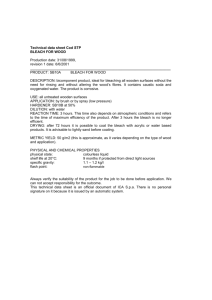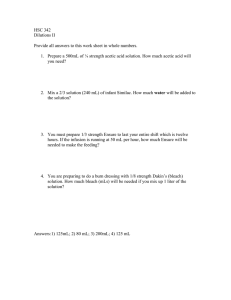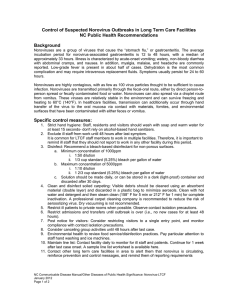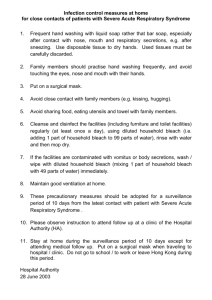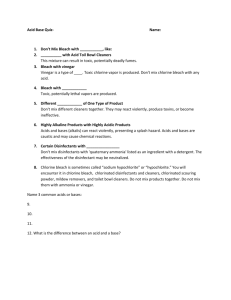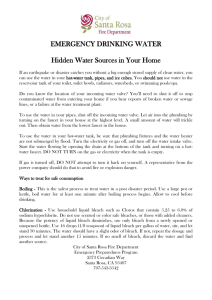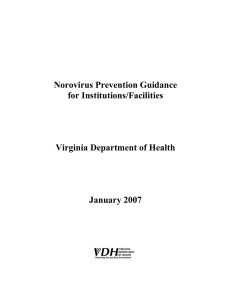North Carolina Department of Environment and Natural Resources Beverly Eaves Perdue
advertisement
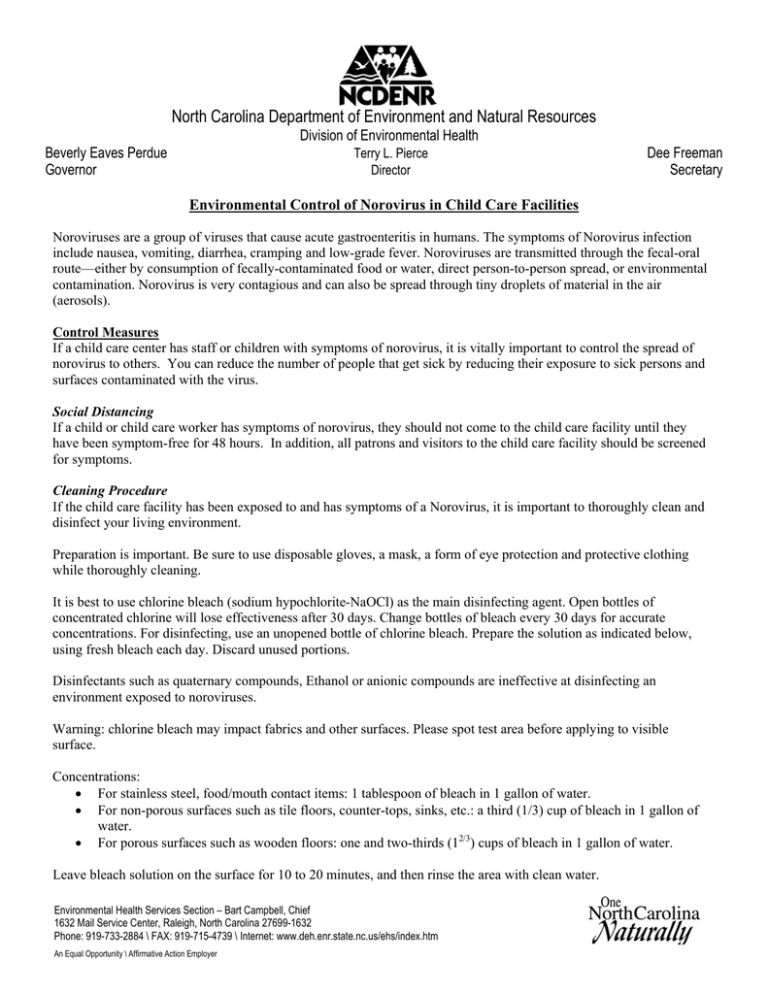
North Carolina Department of Environment and Natural Resources Division of Environmental Health Beverly Eaves Perdue Governor Terry L. Pierce Director Dee Freeman Secretary Environmental Control of Norovirus in Child Care Facilities Noroviruses are a group of viruses that cause acute gastroenteritis in humans. The symptoms of Norovirus infection include nausea, vomiting, diarrhea, cramping and low-grade fever. Noroviruses are transmitted through the fecal-oral route—either by consumption of fecally-contaminated food or water, direct person-to-person spread, or environmental contamination. Norovirus is very contagious and can also be spread through tiny droplets of material in the air (aerosols). Control Measures If a child care center has staff or children with symptoms of norovirus, it is vitally important to control the spread of norovirus to others. You can reduce the number of people that get sick by reducing their exposure to sick persons and surfaces contaminated with the virus. Social Distancing If a child or child care worker has symptoms of norovirus, they should not come to the child care facility until they have been symptom-free for 48 hours. In addition, all patrons and visitors to the child care facility should be screened for symptoms. Cleaning Procedure If the child care facility has been exposed to and has symptoms of a Norovirus, it is important to thoroughly clean and disinfect your living environment. Preparation is important. Be sure to use disposable gloves, a mask, a form of eye protection and protective clothing while thoroughly cleaning. It is best to use chlorine bleach (sodium hypochlorite-NaOCl) as the main disinfecting agent. Open bottles of concentrated chlorine will lose effectiveness after 30 days. Change bottles of bleach every 30 days for accurate concentrations. For disinfecting, use an unopened bottle of chlorine bleach. Prepare the solution as indicated below, using fresh bleach each day. Discard unused portions. Disinfectants such as quaternary compounds, Ethanol or anionic compounds are ineffective at disinfecting an environment exposed to noroviruses. Warning: chlorine bleach may impact fabrics and other surfaces. Please spot test area before applying to visible surface. Concentrations: • For stainless steel, food/mouth contact items: 1 tablespoon of bleach in 1 gallon of water. • For non-porous surfaces such as tile floors, counter-tops, sinks, etc.: a third (1/3) cup of bleach in 1 gallon of water. • For porous surfaces such as wooden floors: one and two-thirds (12/3) cups of bleach in 1 gallon of water. Leave bleach solution on the surface for 10 to 20 minutes, and then rinse the area with clean water. Environmental Health Services Section – Bart Campbell, Chief 1632 Mail Service Center, Raleigh, North Carolina 27699-1632 Phone: 919-733-2884 \ FAX: 919-715-4739 \ Internet: www.deh.enr.state.nc.us/ehs/index.htm An Equal Opportunity \ Affirmative Action Employer After the disinfection process is complete, close off the area, if possible, for at least one hour. If there are windows, air out the area. Wash and sanitize hands thoroughly before resuming work. Special Cases/Areas For areas exposed to vomiting or feces contamination: • Use paper towels to soak up as much of the contaminated material as possible, being careful not to drip or splash the material. • Clean and disinfect the entire area with disposable cloths. • Dispose of all waste material in sealed plastic bags. For carpeted areas: • Remove all visible debris with absorbent material. Discard in a plastic bag to minimize aerosols. • Steam clean the carpet to 170 degrees Fahrenheit for five minutes or 212 degrees Fahrenheit for one minute for complete inactivation of the virus. For linens, clothing or textiles: • If soiled, vomit or stool should be carefully removed to minimize aerosols. • Keep contaminated and uncontaminated clothes separate. • Reduce disruption of soiled linens and laundry. • Wash items in a pre-wash cycle. Then, use a regular wash cycle—using detergent— and dry separately from uncontaminated clothing at high temperature greater than 170 degrees Fahrenheit. • Make sure clean and soiled linens, clothing or textiles remain separated. For surfaces corrodible or damageable by bleach: • The Environmental Protection Agency registered phenolic solutions (such as concentrated Lysol® or concentrated Pinesol®) mixed at two to four times the manufacturer’s recommended concentration as best for surfaces that could be damaged by bleach.
